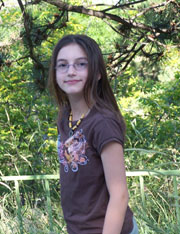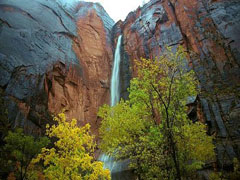On the edge of the Colorado Plateau, in Southwestern Utah, towers an
imposing beauty. It's none other than the 229 square mile (147,000 acres,
593.11 kilometers) Zion Canyon. >From experience, I can say that Zion
is a wonderful park to plan a vacation around.
Wherever one looks in Zion, the eye immediately catches the majestic,
colossal sandstone cliffs that jut out of the desert landscape. They range
in a variety of diverse colors and hues, especially reds, such as crimson
and auburn. These sedimentary rock features are some of the highest in
the world. In addition to these sandstone cliffs, limestone, mudstone,
conglomerate, and shale cliffs also model for the clicking cameras.
Another exquisite feature is the Virgin River and its tributaries; they
eroded and carved the formations of the canyon over the centuries. Actually,
Zion's river system is one of the last mostly free-flowing. The Great
White Throne, peaking at a height of 2,200 feet, is a must-see at this
park. Some others are the 310 foot long Kolob Arch, Checkerboard Mesa,
Weeping Rocks, the Sentinel, the Watchman, the Court of Patriarchs, and
of course, the Narrows of the Virgin River, where after a strenuous hike,
you can walk upstream and touch both sides of the canyon at the same time.
The rough, desert landscape is very diverse with vegetation sprinkled
here and there. In the winter, there are light snow falls, and the days
remain clear and mostly sunny. Approximately 240 million years ago, Zion
used to be a flat basin close to sea level until eroded sand and mud from
mountains nearby was carried by streams to the basin. The material sank
and then it rose. Eventually, with this process of sedimentation, 10,000
feet of sediment, now rock, lifted up.
Zion Canyon is home to numerous plants and animals. It has almost 800
different species of plants, 75 species of mammals, 290 of birds, 32 species
of reptiles and amphibians, and 8 fish, which thrive in the habitat this
natural phenomenon provides. Due to the diverse elevations, amounts of
sunlight, water, and temperatures, "microenvironments" are created.
Mule deer are very common, and in contrast, there are numerous rare animals.
In fact, it is the home of the unique Zion snail.
Zion National Park initiated as Mukuntuweap National Monument in 1909
and increased in size, until 1919, when it was officially given national
park status and the name Zion. Also, the Kolob Canyons were included in
1937. In the ancient Hebrew language, "Zion" meant something
along the lines of safety, protection, refuge. The first Mormon pioneers
in the 1850s, 1860s referred to it that way.
Nowadays, visitors can take scenic hikes or drives through the breath-taking
canyon, check out the Visitor Center, and even the Human History Museum.
There is some evidence of Ancestral Puebloans and the Southern Paiutes.
Though, from April 1 through October 28, only shuttle buses will be allowed
to cruise the park. For schedules and more information on planning a trip
to Zion, you can learn all about it at http://www.zioncanyon.com/.
To make your stay in Utah even more pleasurable, Bryce Canyon National
Park, about one hour's drive form Zion, is certainly another astounding
marvel. Giant upside-down ice cream cones loom ominously with a sharp
drop down to valleys and canyons. These vertical wonders are known as
hoodoos, and can be found in many different colors. Lovely reds and dark
oranges reign upon the others and crown the downy snow in the winter.
10 million years ago, the Earth moved, pulling part land masses including
the Table Cliffs and Paunsaugunt Plateau. Layers were shifted vertically
and displaced, forming the High Plateaus of Utah and the Grand Staircase
stretching from the Grand Canyon to Bryce. Water from ancient rivers eroded
the plateaus taking out some layers and carving the rock. As time passed
by and more erosion occurred (it still happens today) ridges called fins
appeared and eventually wore down to one-of-a-kind hoodoos. The Paria
River and its tributaries run through Bryce, with forests and meadows
here and there. Pinyon pines, ponderosa pines, and junipers dot the lower
elevations, while fir, aspen, and spruce are at higher.
On clear days, especially in the winter, land is visible for miles and
miles ahead. Some places that are the highlights of Bryce Canyon include
Inspiration, Rainbow, Sunset, Sunrise, Yovimpa and Bryce Points. Also,
there is Agua Canyon, where the subtle colors of the hoodoos vividly differ
and stand out on their own. The Poodle and Thors Hammer are creative and
remarkable rock formations that strangely resemble things.
Visitors can also take scenic drives here, making stops at the different
points, but hiking is also available and is-in some peoples' opinions-
a better way to really explore the depths of this truly startling wonder.
Wildlife at this park is easily spotted, and includes mule deer, elk,
pronghorn antelope, Utah prairie dogs, which are endangered, ground squirrels,
marmots, and more. There are also over 160 species of birds to glimpse.
So, whatever the reason, don't forget to pay these national parks a long
visit the next time you're in the vicinity or just on vacation. They are
certainly worth your time; you can take my word for that.
By Simona Kovatcheva

Simona Kovatcheva

Zion Canyon
